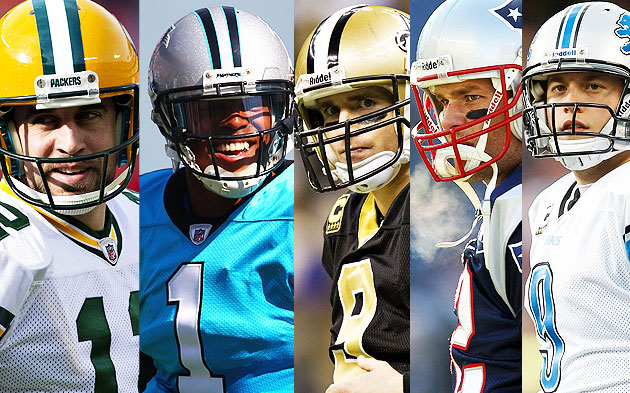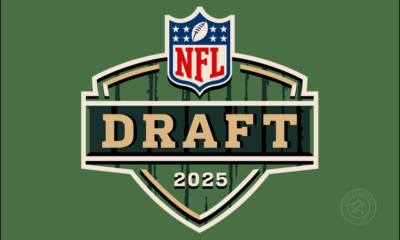
DIFFERENT QUARTERBACKS, DIFFERENT WORKLOADS
Consider a simplified, hypothetical league where teams pass an average of 50% of the time. Some of our quarterbacks’ stat lines look like this:
Nate Normal: 10 pass attempts, 100 yards (20 offensive plays)
Sam Superstar: 20 pass attempts, 200 yards (20 offensive plays)
Robert Rarely: 5 pass attempts, 50 yards (20 offensive plays)
Ben Bustle: 20 pass attempts, 200 yards (40 offensive plays)
Every one of our cutely-named quarterbacks is throwing for 10 yards/pass attempt. A simple comparison of efficiency stats, however, would be misleading. Opposing defenses will play exclusively to defend the pass against Superstar Sam, whereas Robert Rarely will have benefited from opposing defenses loading up against the run.
So what if we compare total production instead of efficiency?
Sam Superstar: 200 yards
Nate Normal: 100 yards
Robert Rarely: 50 yards
Intuitively, that’s the right order of quality comparison for those three. But we run into a problem with Ben Bustle– his arm might be more tired at the end of the day, but he’s producing exactly the same yards/attempt as Nate and getting exactly the same run/pass balance from opposing defenses.
So a good first step in improving our statistical measurements is to replace total production with production per offensive play. For simplicity in comparison, we can make this number similar to typical efficiency stats. Our hypothetical league passes 50% of the time, so we’ll simply measure QB production per every two offensive plays (if they passed 65% of the time, we’d measure QB production per 1.538 plays). We’ll call this stat line
Normalized Total Production:
Sam Superstar: 20 yards per 2 team plays
Nate Normal: 10 yards per 2 team plays
Ben Bustle: 10 yards per 2 team plays
Robert Rarely: 5 yards per 2 team plays
Viola! Nate and Ben now share the same stat line, as they should. But let’s introduce some more quarterbacks:
Desperate Dan: 20 pass attempts, 100 yards (20 offensive plays) = 10 yards per 2 team plays
Evan Efficient: 5 pass attempts, 100 yards (20 offensive plays) = 10 yards per 2 team plays
Dan is tied with Nate for total yards, and tied with both Nate & Ben in our spiffy new Normalized Total Production. He deserves some credit– maybe a lot of credit– for having his opposition play exclusively to defend the pass. But there’s no way he’s as good as Nate Normal. He used up all his team’s snaps to get the same total production.
On the flip side, Evan Efficient is obviously benefiting from opposing defenses that stack up against his team’s frequent handoffs. But he is absolutely better than Nate Normal. Evan got his 100 yards passing on just five plays.
Which finally brings us to Fred & Alvin, realistic examples of what Nate might look like if he were asked to throw more often or allowed to draw in the opposition with more handoffs:
Fred Frequent: 20 pass attempts, 150 yards (20 offensive plays) = 15 yards per 2 team plays (7.5 yards per pass attempt)
Alvin Able: 5 pass attempts, 75 yards (20 offensive plays) = 7.5 yards per 2 team plays (15 yards per pass attempt)
Normalized Total Production overrates Fred and underrates Alvin. But simple efficiency is misleading the other way.
Alas! A crisis has gripped our hypothetical league and, for that matter, the real NFL. How in the world can we compare the quality of quarterbacks when both efficiency stats and total stats are misleading?
Could we… average the two?
Yes!
Sort of.
Taking a straight-up average, or an arithmetical mean, would allow one gaudy measurement to compensate for a poor one. In a bad way. If we averaged the Normalized Total Production and Yards/Attempt, then a quarterback with just one pass attempt for 30 yards (over the course of 20 team plays) would have an average of (3 + 30)/2 = 16.5, which is better than Sam Superstar’s average of (20 + 10)/2 = 15.
Better, then, to use a geometric mean— which is the square root (for two values) of the product of the two numbers. If you’re into math, you’ll see immediately why this is preferable. If you hate math, then you’ll be happy to take my word for it. But if you sort-of get math and are skeptical, here’s an explanation from the compilers of the United Nations Human Index on why it’s a better way (in some cases) to produce an aggregate number:
The geometric mean decreases the level of substitutability between dimensions [being compared] and at the same time ensures that a 1 percent decline in say life expectancy at birth has the same impact on the HDI as a 1 percent decline in education or income. Thus, as a basis for comparisons of achievements, this method is also more respectful of the intrinsic differences across the dimensions than a simple average.
It is the decreased substitutablity that we seek. A quarterback who throws often cannot disguise his poor efficiency with a geometric mean, and a quarterback with a few deep passes cannot disguise his lack of overall production with high efficiency. We want a rating that exposes quarterbacks who producequality at quantity — QQQ.
And for our hypothetical league, it would looke like this:
QB ……. attempts – yds- NTP- yds/att- Geometric mean of NTP and yds/att (QQQ)
Sam Superstar .. 20 – 200 – 20 – 10.0 – 14.1
Evan Efficient . 05 – 100 – 10 – 20.0 – 14.1
Fred Frequent .. 20 – 150 – 15 – 7.50 – 10.6
Alvin Able ….. 05 – 075 -7.5 – 15.0 – 10.6
Nate Normal …. 10 – 100 – 10 – 10.0 – 10.0
Ben Bustle ….. 20 – 200 – 10 – 10.0 – 10.0
Robert Rarely .. 05 – 050 – 05 – 10.0 – 7.1
Desperate Dan .. 20 – 100 – 10 – 05.0 – 7.1
There are other ways we could have produced a similar comparison, such as taking the geometric mean of base efficiency and total production divided by team scrimmage plays. The nice thing about this method is that the final result is really just a more informative efficiency statistic. Any quarterback whose pass percentage is league-average (such as Nate & Ben) will have a QQQ which exactly matches his efficiency rating (yards/attempt), providing a number which is easy to compare to existing statistical models.
ON TO THE REAL NFL….






















Facebook
Twitter
RSS